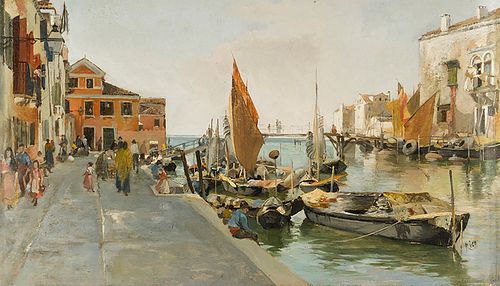MARTÍN RICO ORTEGA (El Escorial, Madrid, 1833 - Venice, 1908). "View of Venice. Oil on panel. Signed in the lower right corner. Provenance: Sala P
Lot 65
About Seller
Setdart Auction House
Carrer Aragó 346
Barcelona
Spain
Setdart Subastas was born in 2004 and is currently the first online art auction in Spain with solidity, prestige and reliability guaranteed by our more than 60,000 users. Setdart has a young, dynamic and enterprising team ready to successfully manage the purchase and sale of art works through custom...Read more
Estimate:
EUR€20,000 - EUR€25,000
$21,052.63 - $26,315.79
Absentee vs Live bid
Two ways to bid:
- Leave a max absentee bid and the platform will bid on your behalf up to your maximum bid during the live auction.
- Bid live during the auction and your bids will be submitted real-time to the auctioneer.
Bid Increments
| Price | Bid Increment |
|---|---|
| EUR€0 | EUR€10 |
| EUR€200 | EUR€25 |
| EUR€500 | EUR€50 |
| EUR€1,000 | EUR€100 |
| EUR€3,000 | EUR€200 |
| EUR€5,000 | EUR€500 |
| EUR€10,000 | EUR€1,000 |
| EUR€20,000 | EUR€2,000 |
| EUR€50,000 | EUR€5,000 |
About Auction
By Setdart Auction House
Oct 27, 2021
Set Reminder
2021-10-27 10:00:00
2021-10-27 10:00:00
America/New_York
Bidsquare
Bidsquare : 19th & 20th Century Paintings & Decorative Arts
https://www.bidsquare.com/auctions/setdart-auction-house/19th-20th-century-paintings-decorative-arts-7767
Setdart Auction House sofia@setdart.com
Setdart Auction House sofia@setdart.com
- Lot Description
MARTÍN RICO ORTEGA (El Escorial, Madrid, 1833 - Venice, 1908). "View of Venice. Oil on panel. Signed in the lower right corner. Provenance: Sala Parés, acquired in 1945. Measures: 42 x 25 cm; 43,3 x 61 cm (frame). After touring several cities painting and holding exhibitions, in 1873 Martín Rico visited Venice for the first time, a city that captivated him and where he finally lived for the rest of his life, alternating with stays in Paris. His Venetian landscapes, in which he captured the brightness and the dazzling life of its streets, became a model for his disciples and copyists to follow. In the present work, the artist immortalizes a corner of the city of canals that is far from the bustle and the classic ducal buildings he was accustomed to depicting. Instead, he shows us a secluded scene starring a group of fishermen preparing to fish, along with families of peasants who stroll through the fish market engaged in their daily tasks. For this Martín Rico uses the technique close to Fortuny, Madrazo and Sorolla that made his work known worldwide already during his lifetime, and that allowed him to show in an exquisite way the beauty of his surroundings. Currently considered the initiator of modern Spanish landscape painting, Martín Rico began his artistic training with his brother, the engraver Bernardo Rico, with whom he collaborated in the workshop of his uncle Calixto Ortega, working as an illustrator. He then studied at the San Fernando School of Fine Arts in Madrid, where he was a disciple of Jenaro Pérez Villamil. At the Liceo of the capital he befriended Fortuny, Rosales and Raimundo de Madrazo, and in 1854 he began a series of trips around Europe, which took him to France, Switzerland, England and Italy. In 1862 he obtained a scholarship to continue his studies in Paris, where he had the opportunity to learn about the work of Meissonier and Daubigny, in whose workshop he began to work the following year. He was friends with some of the first impressionists, such as Camille Pizarro. After touring several cities painting and holding exhibitions, especially in Paris, in 1873 he visited Venice for the first time, portraying its streets on numerous occasions. His views of Toledo, Seville, Granada and Paris were also famous. After participating in the National Exhibitions of the seventies, he did not exhibit again in his native country except in the Bosch Galleries, whose owner the painter considered the only valid dealer in Spain. He was part of the commission of the Universal Exhibitions of Paris in 1878 and 1889, and of the jury at the Chicago Exhibition of 1893. Named artistic director of the publication "Ilustración Española y Americana", among his numerous awards he obtained at the Universal Exhibition of Paris in 1878: silver medal and the title of Knight of the Legion of Honor, as well as another silver medal in the 1889 edition. He also participated in the National Exhibitions of Fine Arts in Madrid, where he was awarded a third medal in 1860. His work enjoyed great commercial success in Paris, where he counted among his clients the American multimillionaire William Ibod Stewart, who owned several of his paintings in his collection. Throughout his work there is an evolution from his initial romantic vision, passing through a realistic stage, to a final style with certain impressionist and fortunyan influences. The influence of Turner and Ruysdael led him to paint increasingly humanized landscapes, and his relationship with Mariano Fortuny deepened this change towards more luminous and impressionist paintings. Currently, Martín Rico's work is present in the Museo del Prado and the Museo de Arte Moderno in Madrid, the Metropolitan and Brooklyn Museums and the Hispanic Society in New York, the Walters Art Gallery in Baltimore, the Museums of Fine Arts in Bilbao and Valencia, among other collections.
- Shipping Info
-
In-house shipping available. Please inquire at admin@setdart.com.
-
- Buyer's Premium



 EUR
EUR CAD
CAD AUD
AUD GBP
GBP MXN
MXN HKD
HKD CNY
CNY MYR
MYR SEK
SEK SGD
SGD CHF
CHF THB
THB

















